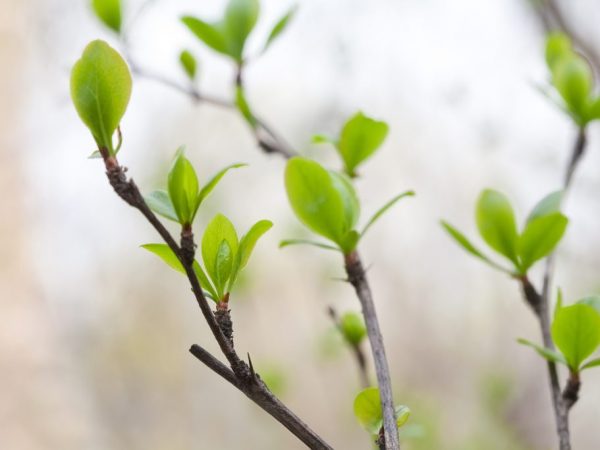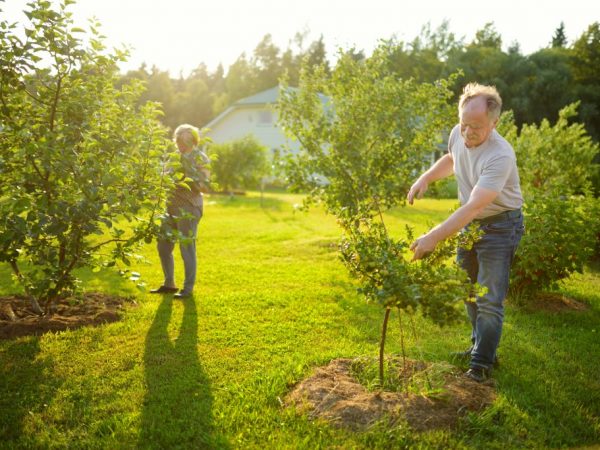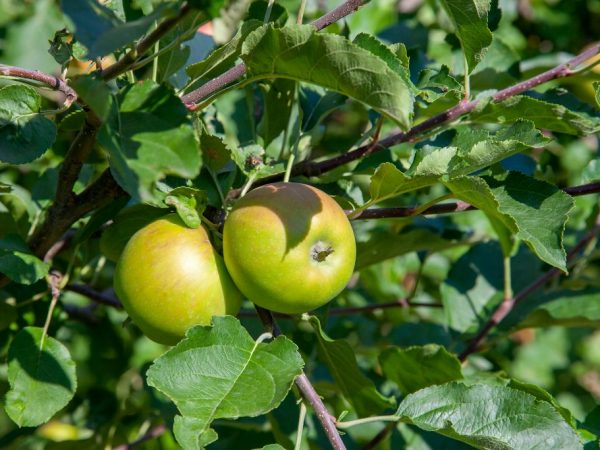Apple growing Ural bulk
As a result of crossing the varieties Ranetka and Papirovka, the Uralskoye nalivnoe apple tree was bred. The hybrid has the best characteristics of popular species - good cold resistance and regular fruiting. The variety is in demand throughout Russia: any of its shortcomings are leveled by proper care.
- Advantages and disadvantages
- Characteristic
- Description of the tree
- Description of the fruit
- Landing
- Disembarkation dates
- Site selection
- Technology
- Care
- Irrigation works
- Top dressing
- Pruning branches and forming a crown
- Treatment of wood from pests
- Ripening and fruiting
- Harvesting and storage
- Variety subspecies
- Growing in different regions
- Gardeners reviews

Apple growing Ural bulk
Advantages and disadvantages
The variety is unique in its properties. It is a frost-resistant hybrid capable of surviving extremely low air temperatures. The apple tree has a high adaptive capacity: the seedling quickly takes root and just as quickly starts up in active growth.
Even under negative conditions, which is the main advantage of the variety, the fruits reach maturity in time.
Another advantage of the species is that it quickly begins to bear fruit.
After 2 years, the apple tree begins to bloom. From this period, the yield increases. Its peak falls at 5-6 years. The average yield of a hybrid is 3 quintals per hectare of garden. Spring frosts are not terrible for the variety - such an advantage is important for regions with short and cold springs.
The hybrid is famous for its delicious fruits that can be stored for several months.
There are few disadvantages of the variety. He can suffer from diseases, but only in those cases when the gardener does not carry out prophylaxis - the immunity of the culture is average. Trees are prone to scab, but they rarely suffer from powdery mildew.
Characteristic
The variety is autumn and fruitful. Fruiting after 2-3 years, and immediately ripe, tasty, full-fledged apples are formed on the branches of a young tree. The yield increase is stable. The ripening period can be extended for a month - from September to October. Regular fruiting is independent of care.
The apple tree is self-fertile. The pollinators in the hybrid are varieties with similar characteristics. The best option is the Uralets apple tree. Pollinating trees bloom in one period. Cross-pollination increases the number of fruits.
General description of the apple variety Ural bulk:
- high winter hardiness, which does not depend on the stock;
- drought resistance;
- branch buds form earlier than other fruit trees.
After ten years of age, the tree bears stable fruit - up to 30 kg of yield from one crop. Over time, it requires less maintenance. The seedlings are resistant, withstand any conditions - they need standard but regular maintenance.
Description of the tree
The variety has a massive tree with a lot of foliage. The crown is moderately thick and dense. The annual growth is stable - up to 60 cm in one year. The first 2-3 years, the branches grow upward, and only then the growth of lateral shoots begins.

The apple tree needs pruning
The crown of the slope to excessive thickening, which helps to cope with two-time pruning. The average height of the crop is 8 m.The more fertile the soil, the higher the Ural bulk plant grows. The growth of the crown occurs every season - even over the years, pruning is not canceled.
Description of the shoots: they are thick and strong. With a crown diameter of at least 4 m, the branches are long. The maximum growth was noted at the age of 15, after which the metabolic processes inside the trunk slow down.
The foliage is elongated, dark green in color. Pubescence is present, but only on the inner part of the plate.
Description of the fruit
Apples are small. The weight of one fruit is 60-70 g. Record-breaking apples weigh up to 200 g, but it is difficult to achieve such a result. The shape of the fruit is round, uniform. Ribbing is weak and almost imperceptible.
The peel has a yellow tint, and the characteristic blush appears only during the ripening period. It is moderately dense, smooth and oily. Light dots under it are visible after ripening of the fruit - the younger the apple, the lighter the peel.
The pulp is tender, dense, juicy, white and without veins. The taste is sweet and sour. You may not feel the honey flavor right away: for this, the fruit needs to "lie down" in a secluded place. The sourness is felt in fruits that have just been torn from the branches. There is no perceptible aroma even with prolonged storage.
Apples grow on a strong stalk. For this reason, they rarely fall to the ground - the harvest hangs on the branches until October, and if there is no frost, the quality of the fruit does not change. The pulp loses its characteristics if stored improperly: it is loose, without moisture and a pronounced taste.
Due to the oily rind, debris and dirt often cling to the fruit. You cannot eat apples without processing.
Chemical composition
Appreciate the fruit of the Ural bulk for its taste. The sweet pulp will not only decorate any dish, but will also be a source of nutrients. It contains at least 10% sugar - hence the sweet, honey taste. Dry soluble substances not less than 15%.
Apple contains ascorbic acid and B vitamins. The beneficial composition of the pulp can be used in dietary nutrition. The fruit is rich in phosphorus, calcium and pectin - useful components for children of any age.
Landing

A healthy seedling is chosen for planting.
Planting a fruit tree is a simple process. It is carried out in three stages. At the first stage, the gardener chooses the planting material, and at the second stage he creates a hole for it. The final stage is planting a young tree in open ground.
The seedling must be:
- vaccinated. This is its main feature. If he is not vaccinated, then he is unable to survive in the new conditions. Purchased materials must be processed in advance. The grafted seedlings have strong roots that do not break when pressed;
- with a formed root system. In order for the seedling to start growing rapidly, the roots must be at least 5-6 cm long. They are elastic, strong, uniform in thickness. Any damage or stains on the root is a good reason not to buy such material;
- with dense bark and no leaves. In addition to the main distinguishing features, the correct planting material must have a dense bark. If you pick it up, gently touch it with a fingernail or any sharp object, there will be a green, juicy crust under it. You cannot choose seedlings with leaves.
Choose biennial crops. One-year-olds are buried in a secluded place until spring, and then inoculated - this is the only way a gardener can prepare planting material. To strengthen the immunity of a young tree, you can soak in a solution "Fitosporin" or in another preparation, but you can do without such a procedure.
Disembarkation dates
In spring and autumn, when horticultural crops are being restored, ideal conditions are created for planting the Uralskoye bulk apple tree. Seedlings with a closed root system can take root at any time of the year, but for them the best period is May or October.
There are differences between these procedures:
- pit preparation. If the gardener is planning a spring procedure, he prepares the pit in the fall.This is the easiest way to enrich the soil. In the fall, he digs a hole that is suitable in size, and then pours fertilizer into it. For the winter, it can be mulched or covered. If this is not possible, the pit is dug in the spring - 2 weeks before the expected date of disembarkation. The autumn procedure involves the creation of a pit 14 days before the day of planting;
- leaving after disembarkation. In the spring, a young tree is transferred to the usual mode for apple culture. Establish watering, fertilization of the soil and carry out pruning. Another case, if the tree was planted in the fall, they water, fertilize and immediately insulate the culture for the winter. The upcoming cold snap after the autumn procedure excludes the usual care - the seedling is not watered or fertilized until spring;
- landmarks, when and how to land. To understand when to perform the procedure, you need to pay attention to the mature trees in the garden. In the spring, fruit crops should not have ovaries, otherwise the time has passed for planting. After winter, the soil warms up, which is important for the formation of a planting pit. In autumn, planting is carried out after harvesting. It is necessary to free the trees from fruits, remove the land from debris and leaves. Only after that a landing pit is formed. The autumn procedure is carried out a month before the expected frost.
In spring and autumn, the tree has enough conditions for growth. Regardless of the region, the planting material is adaptable. The gardener's task is to provide the seedling with moisture and nutrients.
Site selection
The Ural filling has a dense crown, which requires free space. You cannot plant a crop in cramped conditions - as the seedling grows, its branches will grow deformed, crooked. Full-fledged fruits will not be able to form on such shoots.
The availability of free space is an important condition affecting the quantity and quality of the future harvest.

The tree needs sunlight
Select areas without drafts. If there is a shelter or structure nearby, it should not hide the tree from the sun's rays. The variety loves lighted areas. Lowlands are not suitable for planting crops. In such an area, water is collected from the entire site. It spoils the root system, leads to its rotting.
Groundwater that is closer to the surface will harm the seedling. The higher they are, the less nutrients are absorbed by the root system. The maximum height of groundwater is 2.5 m.
Technology
The dimensions of the landing pit are 80 cm deep and 80 cm in diameter. These are the optimal sizes for the root system of the tree. For "filling" the pit, a mixture of manure with water or superphosphate with ash is suitable. If potassium salt is added, then the following proportions of the mixture are needed:
- 100 g of potassium salt;
- 200 g superphosphate;
- 200 g of ash.
The prepared fertilizer is mixed with soil and placed on the bottom of the pit. The mixture is allowed to settle and only after a week they are digging. After that, you need to wait another week and land. The roots are neatly leveled and placed in the pit. Fertile soil without impurities is poured on top.
The top layer of soil is compacted. A soil roller is created around the trunk. It is able to protect the crop from excess moisture and improve the quality of irrigation that will be carried out in the future.
Care
The characteristics of the Uralskoye bulk apple tree do not change due to excessive care. The fruit tree needs watering, fertilizing the soil and loosening it, but only as the soil layer dries up. Additionally, the gardener conducts sanitary and formative pruning, preventive work. Together, the care guarantees a high-quality harvest in September.
Irrigation works
Watering is carried out three times a season. It is harmful to add water more often. If the soil layer dries quickly in summer, a small amount of moisture is added. It is better to use drip irrigation, which will provide nutrition not only to the rhizome, but also to the entire tree.
Water is taken from springs or an ordinary tap liquid is taken.The less impurities it contains, the better the watering will be. The liquid is left outside all day to warm up. After that, irrigation is carried out. In the warm season, the procedure is performed in the evening, otherwise burns will form on the leaves.
It is dangerous for young stems to apply liquid under the root. For these purposes, the gardener creates a trench at a distance of 10-15 cm from the root part of the culture. Water is brought in gradually so that it has time to be absorbed.
The soil is loosened beforehand - the procedure will ensure good soil throughput. Top dressing combined with moisture gives good results.
Top dressing
Foliar dressing is suitable for the variety. For this, mineral mixtures are prepared. They are combined with spraying the tree to enhance the effect. Nitrogen and potassium substances are suitable for foliar dressing.

Foliar dressing will saturate the tree with microelements
Organics are used for a young tree during its active growth. To do this, take slurry or bird droppings. When the apple tree blooms, organic matter is introduced at the root. For the winter, the tree is mulched. Grass, hay or sawdust are used as mulch.
Add peat or nutrients to the base. When snow falls, it is not removed - the snow cover provides additional protection to the crop.
Pruning branches and forming a crown
Pruning is an important procedure for densely crowned trees. The older the crop, the more often it needs pruning. The procedure is carried out with two purposes: to form the crown and to protect the tree from diseases and pests. Events different in purpose are appointed for spring and autumn.
To trim the apple tree in spring, the tools are treated with a disinfectant solution. After that, the moment is chosen when the internal processes of the tree have recovered after winter, but new buds have not yet formed. Old twigs or broken shoots should be removed. The cut sites must be treated with a disinfectant liquid.
Autumnal sanitary pruning is more important than crown formation. This procedure helps in preparing for the winter. The gardener cuts off diseased and damaged branches - in this case, only healthy shoots are left on the tree.
Immediately after the procedure, the apple tree is insulated. If you can do without the spring procedure, then in the fall pruning is a must.
Treatment of wood from pests
Part of prevention and basic care is spraying the tree. Bordeaux liquid is used every three weeks. The mixture helps with scab, which threatens all crops in the garden. The maximum number of treatments is 7 times in one season. Whitewashing in spring and autumn protects the tree from sunburn.
Spraying a tree is carried out in this way:
- the first treatment - before the appearance of the kidneys;
- when the buds bloom, perform a second treatment with Bordeaux liquid;
- before the formation of the fruit, carry out the last sanitary spraying.
During flowering, the tree cannot be processed. Such actions of the gardener will lead to the loss of the crop.
Ripening and fruiting
The variety bears fruit from the second year. If inflorescences appear in the first year, it is better to prune them so that the tree develops further. Brings hybrid apples every year. Fruit branches grow quickly, therefore they provide stable fruiting.
From the third year, the branches are loaded with a large amount of fruit - there is a threat of deformation of the shoots. The average yield per tree is 250 kg.
The peculiarity of apples of the Uralskoye Bulk variety is that they are formed on branches, pods and twigs. Three different types of fruit formation give the same result. The branches age quickly, so they carry out frequent formative pruning.
Harvesting and storage

Apples can be kept fresh for three months
The tree blooms in June. Technical ripeness begins at the end of September, but by October all the fruits ripen and a characteristic blush is formed on their peel.You can harvest in three stages: first of all, in mid-September, fruits are removed for compotes and juices - they have a dense peel.
The second stage is to collect ruddy apples for consumption raw. The final stage coincides with the end of October. The fruits are removed for processing. They are juicy, moderately aromatic and with a soft skin.
The variety has a strong stalk. Even after the arrival of frost, the apples hang on the branches and do not fall off. In the same period, plaque is formed. The quality of the fruit may deteriorate, so you shouldn't delay harvesting.
Fresh apples can be stored for up to 2-3 months. For this, the gardener uses wooden boxes. Good storage conditions are a semi-dark room with moderate air humidity.
Variety subspecies
Adapted apple varieties Ural bulk:
- bushy ranetki;
- semi-cultivated trees;
- large-fruited stanches.
All subspecies are winter-hardy and can withstand sudden changes in temperature. The weight of the fruits of the ranetka does not exceed 15 g, but the culture itself is resistant and not susceptible to common diseases.
Fruit weight from 15 to 30 g in a semi-cultivated apple tree. It grows quickly and does not suffer from powdery mildew. Low winter hardiness and large fruits in the large-fruited subspecies.
Growing in different regions
Ideal conditions for growing the variety have developed in the Urals and Siberia. The harsh winters of these regions are not a hindrance to fruiting - the apple tree gives a stable, high-quality harvest.
Gardeners reviews
Bred for cold winters, the hybrid is very popular among gardeners. This is an unpretentious variety that can survive frost and not lose its quality characteristics. Over the years, the yield of the apple tree increases.
The fruits are distinguished by a high tasting score - this is noted by all gardeners. To plant a culture, various rootstocks are used, which affect the durability of the tree and the fruiting period.

